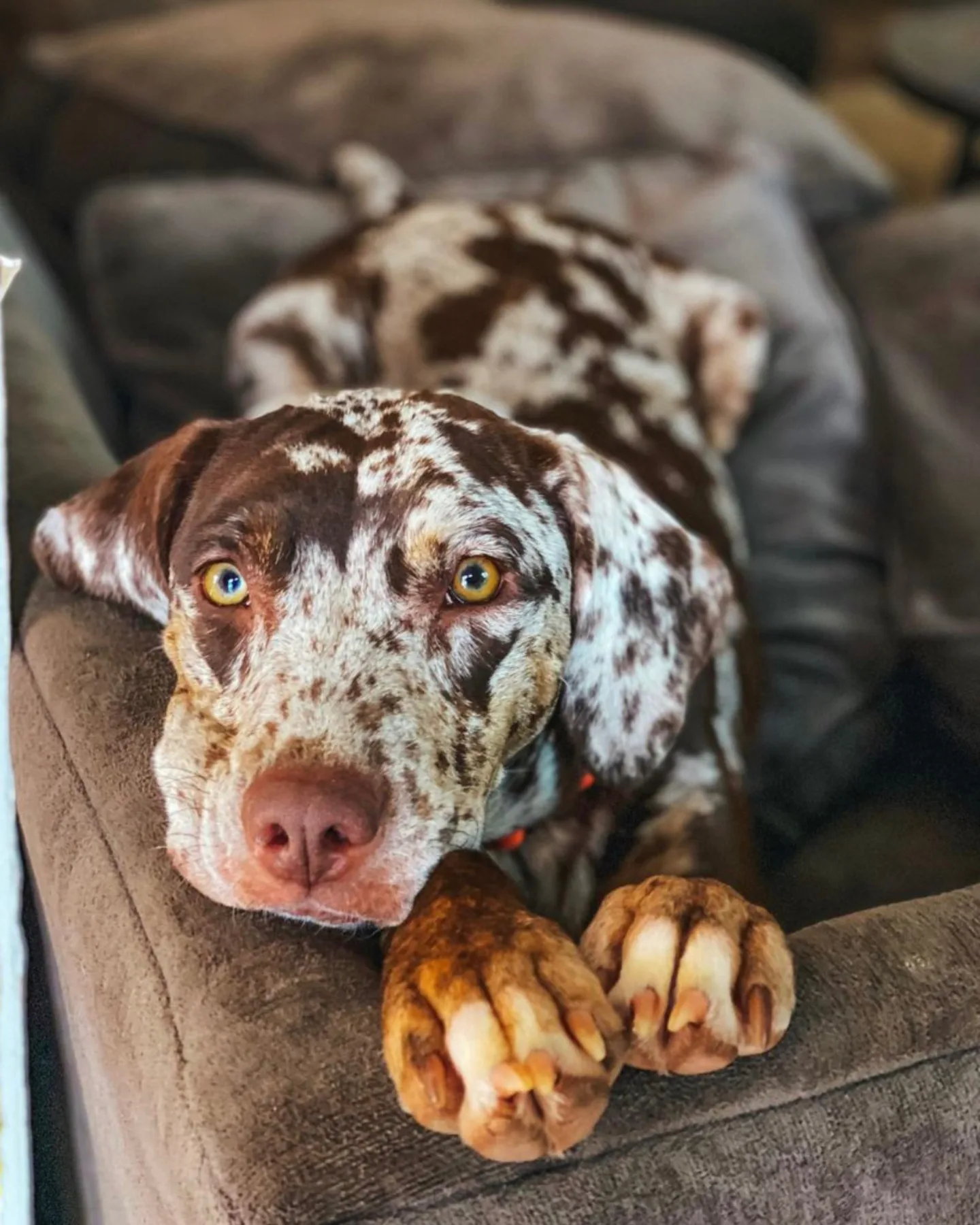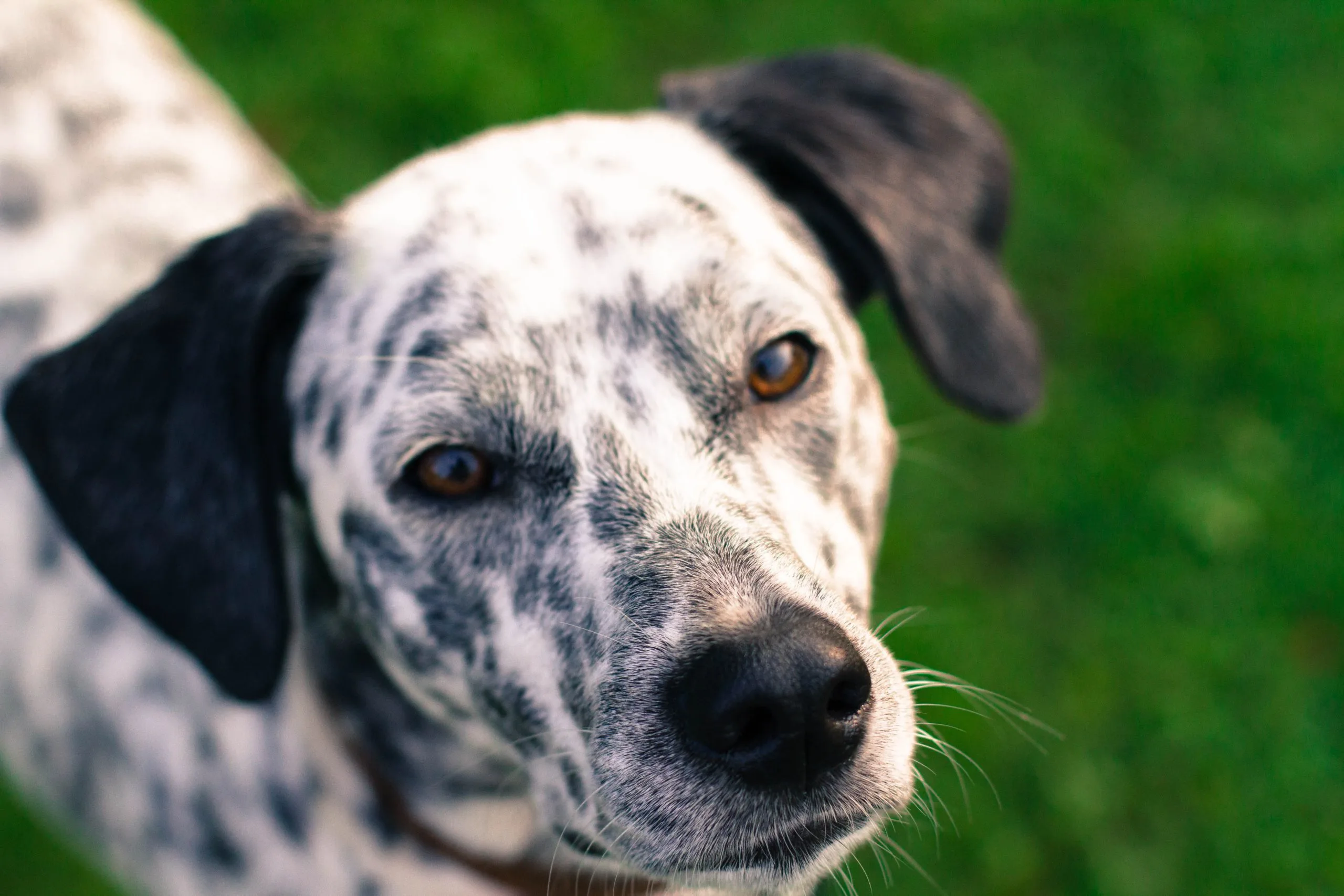The Catahoula Leopard dog originated in the state of Louisiana, where there hunted feral hogs. That’s how they got their adorable nickname, “hog dog”. They were used as stock dogs, bay dogs, tree dogs, watchdogs, hunting dogs, and guard dogs, but also loyal companions. They were also popular among Native Americans who loved to have them around during their hunting trips. Their gorgeous blue eyes and stunning coats added to their charm as well.
Catahoulas are thin, well-muscled dogs that stand at about 2 feet tall. The Catahoula has wide, bright eyes and strong, broad muzzles, which give them a watchful, alert demeanor. Catahoulas are famous for their stunning coat patterns as well as their gorgeous eye colors. They frequently have “glass” and “cracked glass” patterns and resemble slate gray, pale blue, or white. The heterochromatic gene is also present in the Catahoula. This makes it common for the breed to have two distinct eye hues.
Catahoulas are wary of strangers because they were originally used to herd and drive livestock. They look out for their families and have strong opinions about who they can trust and who they can’t. People who live with them say that they have a good sense of who people are. Expect to give this hard-working and independent dog at least an hour of hard exercise every day and firm direction when training. Catahoulas are loving, calm, and loyal friends as long as they get enough exercise and have a leader to follow.
If you want to learn more about this rare and unique dog breed, then keep on reading!
History of the Catahoula Leopard dog
The Catahoula was named after a Choctaw Indian word that means “sacred lake.” They came from northern Louisiana, near Catahoula Lake. All of the Catahoulas that exist now historically descended from three breeding lines, each of which produced dogs of various shapes and colors. They are the offspring of local dogs and the Bloodhounds, Mastiffs, and Greyhounds that Spanish explorers brought to the area. They are sometimes called Catahoula curs, Catahoula leopard curs, or Catahoula hounds.
The variety we observe today is the product of repeated cross-breeding between those three lines throughout time. Black, red, and yellow are examples of single-color coats, while brindle and double-brindle coats are also available. Additionally, you’ll see coats in hues of black, blue, and red with the merle or “leopard” pattern that gives the dog his name. Due to the extreme diversity, mating two solid-colored dogs frequently produces a litter of brindle or merle-coated Catahoula Leopard dog pups.
The National Association of Louisiana Catahoulas was established in 1977 after the Louisiana Catahoula Cur Association in 1976. The American Catahoula Association and the Catahoula Cur Breeders Association are two additional organizations that work to promote and maintain the breed’s conformation and working ability through shows, clinics, trials, and accredited testing. In 1979, the breed was named Louisiana’s state dog. The Catahoula is sometimes referred to as a “hog dog” since it was employed to locate and corral wild hogs that roamed the woodlands.
In 1995, the United Kennel Club became the first national canine registry to officially acknowledge the Catahoula. In 1996, the Catahoula was included to the American Kennel Club’s Foundation Stock Service, which keeps track of uncommon breeds. The Hog Dog cannot take part in AKC conformation competitions because it has not yet fulfilled the conditions for recognition by the AKC.

Source: Instagram (@leveeandbanks)
Personality
When working in the field, the Catahoula Leopard Dog’s disposition is intense, serious, and concentrated; nevertheless, at home with its family, it is protective, fun, and affectionate. Catahoulas aren’t vicious against people if properly socialized from a young age, but they do have a tendency to be apprehensive and distant around strangers.
They can be trained to get along with canines of the opposite sex, but they might grow hostile toward canines of the same sex. Due to their strong prey drive, they are dangerous around cats and other small animals. They make good watchdogs due to their propensity to bark at strangers and their strong protective instincts.
Catahoulas get along well with older kids who know how to treat them with kindness and respect. However, they need to be properly watched around newborns and young children. Families with older kids or teens who are capable of taking part in training and who can handle a firm but gentle touch are best suited for this breed. It’s crucial that everyone in the family treats these dogs decently since they won’t be afraid to protect themselves if they feel mistreated.
Living with a Catahoula Leopard dog
The farm or ranch where there are animals to herd and lots of space to run around and play is where Catahoula Leopard Dogs feel most at home. If not, they require a household with a sizable, fenced-in yard and a place to exercise their instincts for herding and tracking. Your Catahoula will require at least one hour of daily physical activity. For an active pet owner who enjoys jogging, hiking, or long walks, they make a fantastic companion.
This breed cannot be left outside, despite their love of the great outdoors. Catahoulas dislike being left alone for an extended period of time and need to spend lots of time with their human group. When it’s necessary to leave them alone for a few hours, crate training from a young age in conjunction with treat-dispensing puzzle toys to keep them occupied can help keep them calm and confined.
These dogs are highly bright and not too difficult to train. It’s crucial to be tough and patient as well as fair and gentle with them because they do have an independent streak that can make them resistant at times. To gain your Catahoula’s respect and loyalty, be consistent and clear about your expectations. These puppies tend to be motivated by praise and are often eager to please.
Although they can be trained to tolerate other dogs if they are socialized as puppies, Catahoula Leopards thrive best in houses where they are the only animal. They can be taught to coexist with the cats they were raised with, but it’s likely that they’ll view the neighborhood cats and small animals in the yard as amusing targets to chase.
Exercise
Catahoula Leopard dogs need a lot of physical and mental activity to be happy and well-behaved at home. If they don’t get their energy out constructively, they’re likely to act in destructive ways. Aim to be active for at least two hours a day by taking walks, running, riding a bike, swimming, hiking, or playing hard. Dog sports like agility and rally are also great ways to challenge both a Catahoula’s mind and body. And if you need a break, puzzle toys can keep your dog busy.
The Catahoula is not the kind of dog you can just tie up in the yard and leave alone. They need to be with other people and move around, and they should be welcome to the inside of your house as well as the outside. Electronic fences that go underground won’t work for this breed. Catahoulas aren’t afraid to attach when another dog comes close to their territory. If there isn’t a solid barrier, other dogs can get into the yard and start a fight.
Grooming needs
The Louisiana Catahoula Leopard dog has a single coat that is short to medium in length and lies close to the body. They have a varied coat that can feel anywhere from smooth to rough. The Catahoula’s coat stays clean and shiny and sheds less with weekly brushing. The coat sheds a little to moderate all year. Most of the time, they only need to take a bath a few times a year. Unless your Catahoula Leopard dog enjoys rolling in the mud.
Taking care of your dog’s teeth and nails are also important parts of grooming. At least twice or three times a week, you should brush your Catahoula’s teeth to get rid of tartar and the bacteria that come with it. Daily would be ideal, but either one will keep dog dental problems away. Once or twice a month, or as needed, trim their nails. If you aren’t sure how to do it yourself, ask your dog groomer to do it for you. Lastly, also make sure you clean their ears with cotton balls and a dog ear cleaning solution.
Start grooming and brushing your dog while he is still a puppy. This will make it so much easier for you, your groomer, and your vet to take care of your dog in the future. Make grooming a positive experience by giving them treats and verbal praise.
Training
Start training your new Catahoula puppy the day you bring it home. They are smart and quick to learn, but they need a strong leader. Be persistent, firm, and patient with your Catahoula. You’ll get the best results and build the strongest bond possible with it. Always look for good habits to praise instead of bad ones to correct. A harsh punishment could hurt the dog’s personality and sense of self-worth. They thrive on positive reinforcement.
The Catahoula is an easy dog to train to go to the bathroom outside if you are consistent and follow a routine. Crate training helps with this process because it keeps your Catahoula puppy from chewing on the wrong things or getting into trouble when you’re not around to watch. A box also gives them a place to hide when they are feeling overwhelmed or tired. Never use a crate as a place to punish your pup.
Your Catahoula will be a strong puller, so it’s important to leash train him. Your muscles’ health depends on how well your dog behaves on the leash. They have a strong need to hunt, so don’t let them run free in places where they might meet dogs or other animals they don’t know.
If you want your Catahoula to get along with other animals, especially other dogs, it needs to meet them early and often. Puppy classes are a great way to start socializing your dog, but you shouldn’t stop there. Introduce them to as many people as you can, both at home and in public. With the right training, consistency, and socialization, your Catahoula will become a great family member who will protect you and love you no matter what.
Health
This breed is resilient and often has minimal health issues. They are susceptible to hip dysplasia, like many huge breeds, although respectable breeders should check them for it. A hip exam from the Orthopedic Foundation for Animals should be included in the health clearances for both parents if you buy a Catahoula puppy from a reputable breeder.
Deafness, a trait genetically connected to the gene for merle coloring, may also be a problem with this breed. You can test your Catahoula’s hearing before taking it home. But bear in mind that while deafness will necessitate some small concessions, hearing-impaired canines can still live a long, happy, and fulfilled life.
Thankfully, most Catahoula Leopard dogs will live a long and healthy life, with a life span of 10 to 14 years. It’s up to you to ensure your dog lives a healthy lifestyle, with a balanced diet, enough exercise, and regular vet visits. That won’t only keep him healthy, but also help you form a strong bond with your canine.

Source: Instagram (@hula_catahoula__cleopatra)
Conclusion
The Louisiana Catahoula Leopard dog, also known as the Catahoula hog dog, can be a great companion dog for many different people. They are alert watchdogs, but also great family dogs farm work canines, or workout buddies.
The Catahoula Leopard dog breed isn’t the best choice for first-time dog owners. They need consistent training, and early socialization, have very high physical needs, and therefore need lots of exercise. These dogs have strong leadership needs, and you need to position yourself as the leader of their pack.
They aren’t the best choice for people with small children, as they have a lot of strength and can easily hurt someone smaller than them. Before getting one of these pups, inform yourself about the possible health problems, such as hearing loss. Responsible breeders will make sure to check all their dogs for such health conditions. So if you want a healthy puppy, make sure you are buying from a good breeder.
Their unique coat patterns with merle colorations, leopard patterns, with stunning base colors will catch the attention of everyone in the dog park. These dogs are beautiful outside and out. If you are able to give them a lot of love and firm guidance, then look no further.

